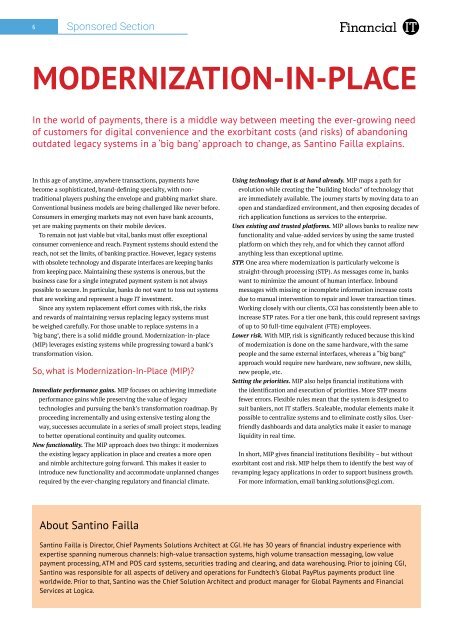Revolutionizing the Financial Markets
Cím: Forradalmasítja a pénzügyi piacok Leírást/ellenőrzések: Több mint 100 000 előfizetőt, amelyek 70 %-a bankok, a pénzügyi az összpontosított közzététele a vezető pénzügyi technológiai hírek a világ, beleértve a technológia blockchain és a cryptocurrencies.
Cím: Forradalmasítja a pénzügyi piacok
Leírást/ellenőrzések: Több mint 100 000 előfizetőt, amelyek 70 %-a bankok, a pénzügyi az összpontosított közzététele a vezető pénzügyi technológiai hírek a világ, beleértve a technológia blockchain és a cryptocurrencies.
- No tags were found...
Create successful ePaper yourself
Turn your PDF publications into a flip-book with our unique Google optimized e-Paper software.
6<br />
Sponsored Section<br />
MODERNIZATION-IN-PLACE<br />
In <strong>the</strong> world of payments, <strong>the</strong>re is a middle way between meeting <strong>the</strong> ever-growing need<br />
of customers for digital convenience and <strong>the</strong> exorbitant costs (and risks) of abandoning<br />
outdated legacy systems in a ‘big bang’ approach to change, as Santino Failla explains.<br />
In this age of anytime, anywhere transactions, payments have<br />
become a sophisticated, brand-defining specialty, with nontraditional<br />
players pushing <strong>the</strong> envelope and grabbing market share.<br />
Conventional business models are being challenged like never before.<br />
Consumers in emerging markets may not even have bank accounts,<br />
yet are making payments on <strong>the</strong>ir mobile devices.<br />
To remain not just viable but vital, banks must offer exceptional<br />
consumer convenience and reach. Payment systems should extend <strong>the</strong><br />
reach, not set <strong>the</strong> limits, of banking practice. However, legacy systems<br />
with obsolete technology and disparate interfaces are keeping banks<br />
from keeping pace. Maintaining <strong>the</strong>se systems is onerous, but <strong>the</strong><br />
business case for a single integrated payment system is not always<br />
possible to secure. In particular, banks do not want to toss out systems<br />
that are working and represent a huge IT investment.<br />
Since any system replacement effort comes with risk, <strong>the</strong> risks<br />
and rewards of maintaining versus replacing legacy systems must<br />
be weighed carefully. For those unable to replace systems in a<br />
‘big bang’, <strong>the</strong>re is a solid middle ground. Modernization-in-place<br />
(MIP) leverages existing systems while progressing toward a bank’s<br />
transformation vision.<br />
So, what is Modernization-In-Place (MIP)?<br />
Immediate performance gains. MIP focuses on achieving immediate<br />
performance gains while preserving <strong>the</strong> value of legacy<br />
technologies and pursuing <strong>the</strong> bank’s transformation roadmap. By<br />
proceeding incrementally and using extensive testing along <strong>the</strong><br />
way, successes accumulate in a series of small project steps, leading<br />
to better operational continuity and quality outcomes.<br />
New functionality. The MIP approach does two things: it modernizes<br />
<strong>the</strong> existing legacy application in place and creates a more open<br />
and nimble architecture going forward. This makes it easier to<br />
introduce new functionality and accommodate unplanned changes<br />
required by <strong>the</strong> ever-changing regulatory and financial climate.<br />
Using technology that is at hand already. MIP maps a path for<br />
evolution while creating <strong>the</strong> “building blocks” of technology that<br />
are immediately available. The journey starts by moving data to an<br />
open and standardized environment, and <strong>the</strong>n exposing decades of<br />
rich application functions as services to <strong>the</strong> enterprise.<br />
Uses existing and trusted platforms. MIP allows banks to realize new<br />
functionality and value-added services by using <strong>the</strong> same trusted<br />
platform on which <strong>the</strong>y rely, and for which <strong>the</strong>y cannot afford<br />
anything less than exceptional uptime.<br />
STP. One area where modernization is particularly welcome is<br />
straight-through processing (STP). As messages come in, banks<br />
want to minimize <strong>the</strong> amount of human interface. Inbound<br />
messages with missing or incomplete information increase costs<br />
due to manual intervention to repair and lower transaction times.<br />
Working closely with our clients, CGI has consistently been able to<br />
increase STP rates. For a tier one bank, this could represent savings<br />
of up to 50 full-time equivalent (FTE) employees.<br />
Lower risk. With MIP, risk is significantly reduced because this kind<br />
of modernization is done on <strong>the</strong> same hardware, with <strong>the</strong> same<br />
people and <strong>the</strong> same external interfaces, whereas a “big bang”<br />
approach would require new hardware, new software, new skills,<br />
new people, etc.<br />
Setting <strong>the</strong> priorities. MIP also helps financial institutions with<br />
<strong>the</strong> identification and execution of priorities. More STP means<br />
fewer errors. Flexible rules mean that <strong>the</strong> system is designed to<br />
suit bankers, not IT staffers. Scaleable, modular elements make it<br />
possible to centralize systems and to eliminate costly silos. Userfriendly<br />
dashboards and data analytics make it easier to manage<br />
liquidity in real time.<br />
In short, MIP gives financial institutions flexibility – but without<br />
exorbitant cost and risk. MIP helps <strong>the</strong>m to identify <strong>the</strong> best way of<br />
revamping legacy applications in order to support business growth.<br />
For more information, email banking.solutions@cgi.com.<br />
About Santino Failla<br />
Santino Failla is Director, Chief Payments Solutions Architect at CGI. He has 30 years of financial industry experience with<br />
expertise spanning numerous channels: high-value transaction systems, high volume transaction messaging, low value<br />
payment processing, ATM and POS card systems, securities trading and clearing, and data warehousing. Prior to joining CGI,<br />
Santino was responsible for all aspects of delivery and operations for Fundtech’s Global PayPlus payments product line<br />
worldwide. Prior to that, Santino was <strong>the</strong> Chief Solution Architect and product manager for Global Payments and <strong>Financial</strong><br />
Services at Logica.



